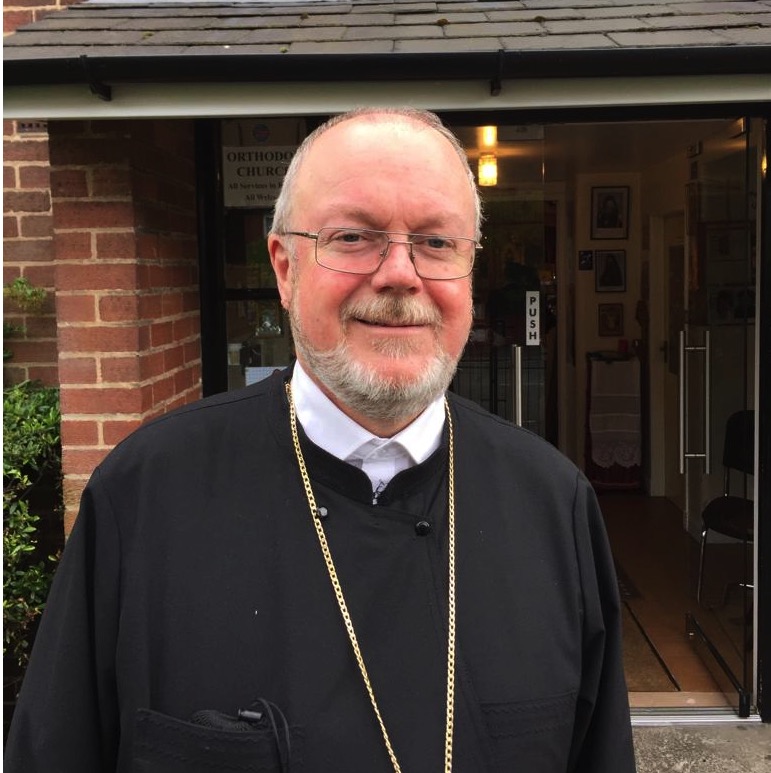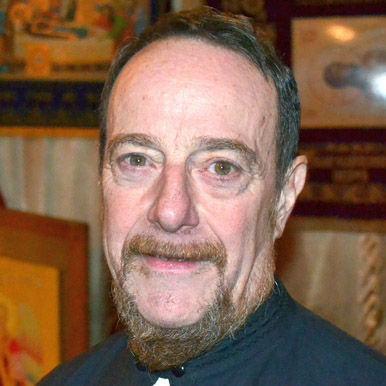The Icon of the Invisible God
Today we celebrate a wonderful achievement in the Orthodox Church, a victory even. Over 1200 years ago in 787 AD, the Fathers of the Seventh Ecumenical Council met in the same city that their predecessors had met for the first Council, Nicaea. The issue for the seventh Council in respect of the legitimacy of the use of icons in the churches was actually connected to both the first and second Councils. In the first and second, the issue had been the Incarnation. Against Arius, the Fathers taught that Christ was true God and true Man. No one could be saved if God Himself had not come in the flesh to unravel the corruption of death and sin; if He had not in person come to bring new life to the world, in fact a New Creation.
In the eighth and the ninth centuries (not final settled until 843 AD) there had been a new challenge to the Incarnation, no doubt accelerated by the rise of the severely iconoclastic Islam in the Near East. This time curiously it was not Christ Himself that was the issue but how He (and by extension, His Mother and the saints) could be represented in the churches. The Church had always recognised the connection between the Incarnation of the Word and the iconographic portrayal of Christ, His Mother and all the saints, all the way back to St Luke the first iconographer of the Christian era. St. John of Damascus had written wonderfully about this question in his defence of the use of icons in worship. Notice how he bases his argument on the Incarnation of Christ ...
(From St. John of Damascus (On the Divine Images, First Apology no. 16) ...
“In former times God, who is without form or body, could never be depicted. But now when God is seen in the flesh conversing with men, I make an image of the God whom I see. I do not worship matter; I worship the Creator of matter who became matter for my sake, who willed to take His abode in matter; who worked out my salvation through matter. Never will I cease honouring the matter which wrought my salvation! I honour it, but not as God. How could God be born out of things which have no existence in themselves? God’s body is God because it is joined to His person by a union which shall never pass away. The divine nature remains the same; the flesh created in time is quickened by a reason-endowed soul. Because of this I salute all remaining matter with reverence, because God has filled it with His grace and power.”
This then was the Orthodox Christian approach to the material world upheld by the 7th Council, veneration. When God came in the flesh he not only rescued humanity from sin and death but creation itself received new hope as its priest, “homo sapiens” recovered communion with God through repentance and faith and entered back into a right relationship with the material world.
Before the incarnation there had been the necessity of limiting figurative art in worship (Exodus 20:4-5) to avoid the idolatry of the surrounding pagan nations infiltrating Israel.
After the Incarnation, these restrictions were necessarily removed because the Logos was now not only heard but seen. The Incarnation of the Word created a new potential in matter to be grace bearing in all its aspects; not just in former times the invisible Word but now the image of the Word-Logos, together with images of his friends, the saints, full of the Holy Spirit.
St Paul confessed this when he wrote of the liberation of the Cosmos through the regeneration of the redeemed. In Romans 8 he declares:
18 “For I consider that the sufferings of this present time are not worthy to be compared with the glory which shall be revealed in us. 19 For the earnest expectation of the creation eagerly waits for the revealing of the sons of God. 20 For the creation was subjected to futility, not willingly, but because of Him who subjected it in hope; 21 because the creation itself also will be delivered from the bondage of corruption into the glorious liberty of the children of God. 22 For we know that the whole creation groans and labours with birth pangs together until now. 23 Not only that, but we also who have the firstfruits of the Spirit, even we ourselves groan within ourselves, eagerly waiting for the adoption, the redemption of our body.”
However, today the Orthodox often find themselves in western post-Christian cultures where there is a very different approach to matter; or rather two approaches, both of them heretical, both of them iconoclastic.
The first we might characterise as matter stripped of spirit and spirit stripped of matter. In “matter stripped of spirit”, the material world loses its contact with the divine. It may safely be plundered and human bodies effectively treated as so much “meat” or even genomic bio-parts to be tinkered with at will. The reverse heresy, “spirit stripped of matter” is the religious counterpart of “matter stripped of spirit.” Salvation according to this heresy only concerns the soul and not the body. So, churches subscribing to this error deny the social, political and environmental implications of the gospel. For these modern-day gnostic heretics, salvation is an escape from the world in an isolated spiritual bubble, not a power to transform of the world. They believe not in the resurrection of the body, the flesh being for them a second-rate or even evil thing, but rather in life after death as some sort of vague notion of spirit survival beyond death, which, when alloyed with sentimentalism ends up with the nonsense of all of us becoming angels or stars.
The second group of heresies concerns making things and the pursuit of things into God, or, the other way round, making God into things. Matter stripped of spirit translated into materialism or matter becoming spirit without distinction, pantheism and animism. The first concerns the idolatry of consumerism, of measuring oneself by one’s possessions rather than the dignity of being made in God’s image and likeness. The reverse corollary of making things into God, is the idolatry of false creation mysticism, most notably encountered nowadays in the resurgence of New Age paganism with its naturalisation of the divine in its historic earth-bound rituals.
By contrast, Orthodox Christianity venerates the material world as grace-bearing; first and foremost in the iconography of the sacred Person of Jesus Christ, the Incarnate (enfleshed) Word of God, and by extension, toward all disclosures of the divine energies under physical form, ranging from the Holy Mysteries (a different sort of Divine Presence) to the poor whom we are called to serve and then, from the lowliest speck of dust to the whole Cosmos. This Creation, this handiwork of God which He called “good” as recorded in Genesis 1, is called to participate in the Kingdom of God, the Trinity manifest in creation but also being entirely beyond it. In the same manner, icons, sacraments, human persons, even inanimate creation itself points beyond to the reality of the God Who, from within that creation, is making all things new.
Finally, we need to consider the 7th Council in the realm of prayer. Prayer in the Orthodox Church is the disciplined mind descending into a purified heart, there to commune with God. This prayer is without the faculty of imagination. The voluntary creation and stimulation of images in the mind can often be undisciplined thing, and in the context of prayer, it can easily be both corrupted and corrupting by egotism and disordered passions.
This is a huge difference here between Orthodox spirituality and that of the late Latin west where imagination in prayer has been actively encouraged since the 14th century (the Devotio Moderna movement). This has often given rise to febrile, even sexualised psychic states which have misled many into thinking that they are drawing closer to God whereas in fact the very opposite is happening. This is revealed in a startling manner by Bernini’s sculpture: “The Ecstasy of St Teresa (of Avila)” [1647-1652] with strong sexual imagery being used to convey mystical union with God. This may also be discerned in Blake’s poem: “Jerusalem” later set to music as a western hymn.
There is a place for imagination in works of art and literature but not in prayer. For the Orthodox, prayer is without images. Not everything that pops up into our minds is of or from God. There is an asceticism in prayer that requires the banishing of all images. This being the case, what of the use of icons and the 7th Council? How do we reconcile the apparent contradiction here?
The answer is quite simple. When we behold an icon, our attention is focussed on the person who is the prototype of the image. The veneration of an icon is an ascetical discipline to prepare us from prayer-without-image. When we enter into prayer, we leave every image behind, including that of the icon; but we need the icon initially to focus our attention and devotion.
Many books have been written by heterodox modern western Christians who genuinely appreciate icons but who also misapply them by encouraging people to use icons as content for meditation. Mostly we might say that this is harmless, but it does have potential for harm, especially when those meditations are guided by someone else, in a book or in person. It is in fact quite easy for someone to manipulate another person through guided meditation of this sort, meditation with images. The author once had an occasion to be aware of this danger (before of course he became Orthodox) in leading a group meditation on Scripture. So, there is no contradiction here between the veneration of icons and prayer, but only in an Orthodox context may this be safely understood and practised.
This celebration of the restoration of the holy icons which we mark in October’s feast of the Father’s of the Seventh Ecumenical Council is then a great message of hope for our humanity and the Cosmos itself. It affirms that nothing that God has made will or should be wasted, despised or lost. We look upon the holy icons and we kiss them for in their prototypes we see a New Creation born out of the Resurrection of Christ, in Whom all things are made new and radiant in God. We access these glories by faith and in prayer prompted sometimes by the holy icons but then realised without mental images of any sort.
Archpriest Gregory Hallam 11th October 2020

 Archpriest Gregory Hallam
Archpriest Gregory Hallam
 Fr. Emmanuel Kahn
Fr. Emmanuel Kahn